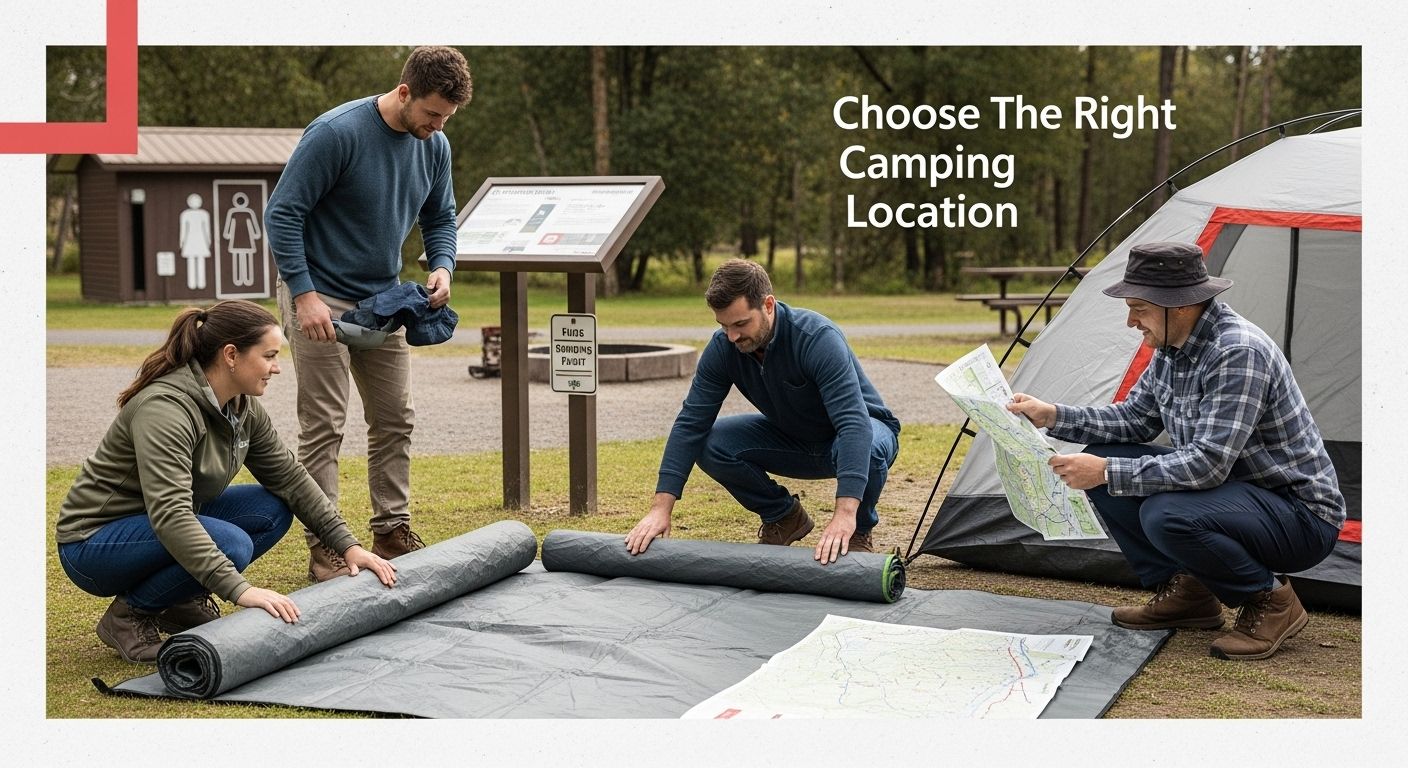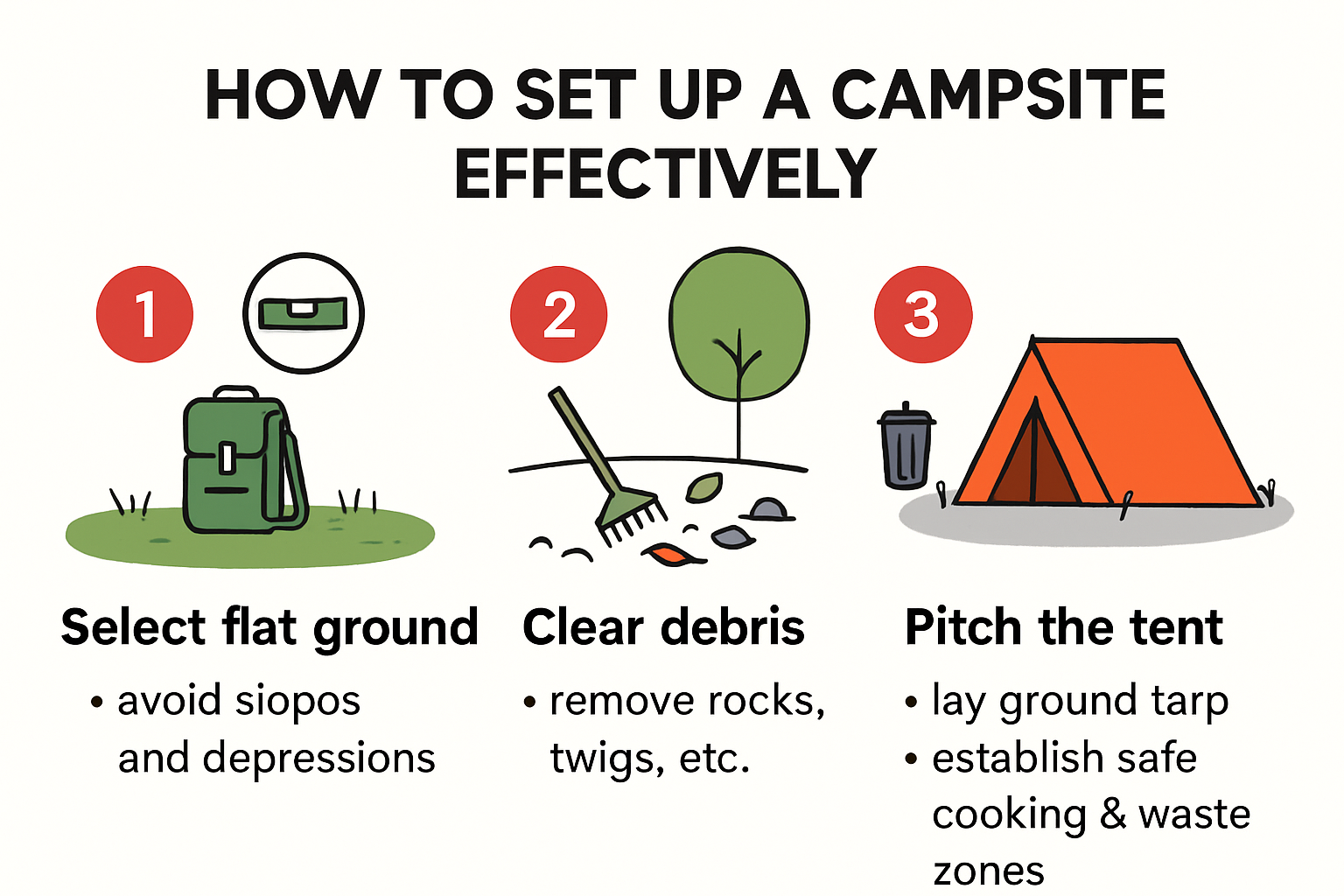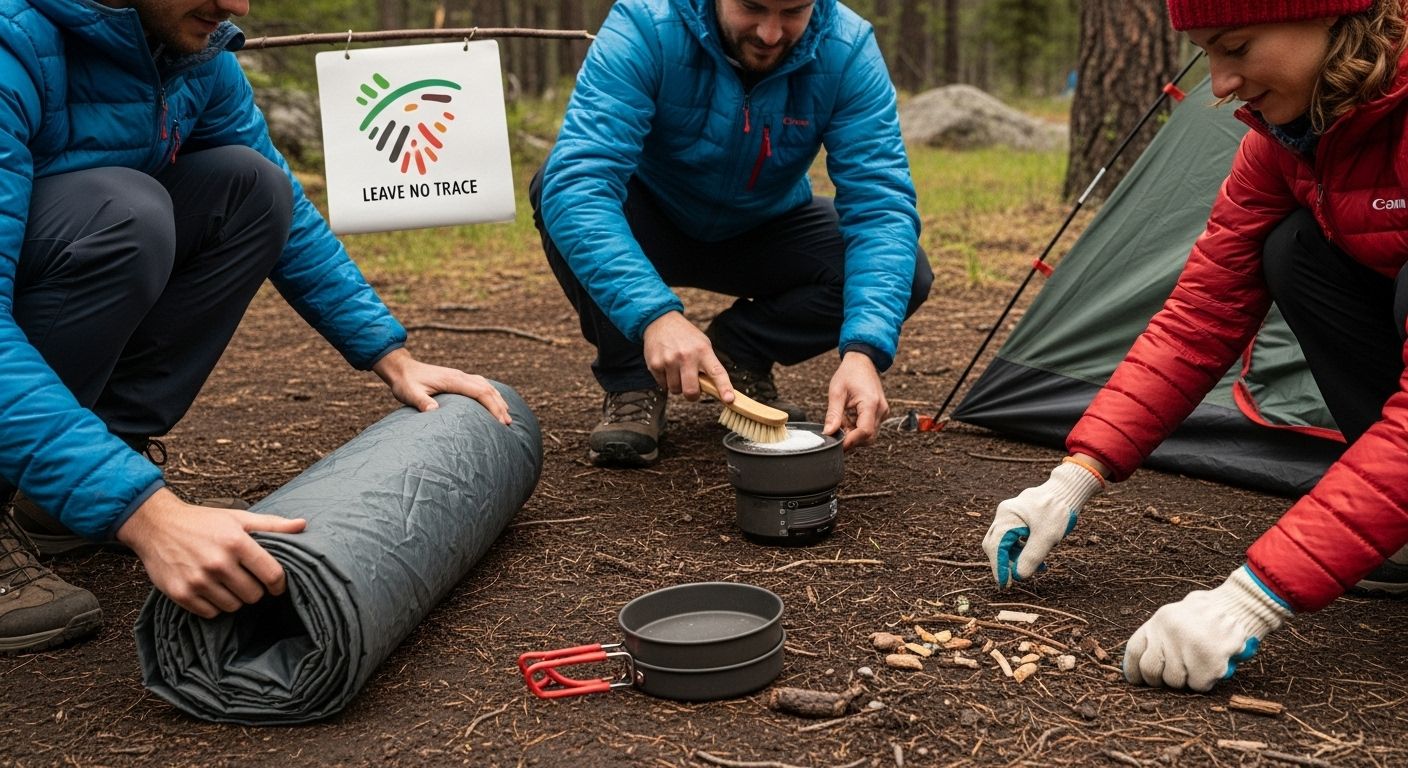Essential Camping Tips for Beginners: Master Your Adventure
Full Disclosure: Our AI Assistant Writes These!
While we're out in the bush tracking leopards, dodging elephants, and trying to get the perfect sunset shot, our trusty AI companion is back at camp, diligently crafting these blog posts. Don't worry though - it's been trained on years of real safari experiences and only occasionally suggests that tourists should pet the lions. (Please don't pet the lions. The AI was joking. We hope.)
The real reason? SEO loves fresh content, and we love fresh adventures. So while our AI handles the keywords and search rankings, we're out there finding the next hidden waterhole, secret viewpoint, or that one tree where the leopards always hang out. Win-win, really!
Essential Camping Tips for Beginners: Master Your Adventure
Camping offers the chance to escape into nature and enjoy the fresh air, but picking the right campsite can actually make or break your holiday. People often worry about fancy gear or bush skills, but flat ground and basic amenities at established campgrounds can make your first trip up to ten times more enjoyable for beginners. What most new campers miss is that smart prep and small site choices are the real secret to a stress-free outdoor adventure.

Table of Contents
- Step 1: Choose The Right Camping Location
- Step 2: Gather Essential Camping Gear
- Step 3: Plan Your Itinerary And Meals
- Step 4: Set Up Your Campsite Effectively
- Step 5: Engage In Outdoor Activities Safely
- Step 6: Leave No Trace And Pack Up Responsibly
Quick Summary
| Key Point | Explanation |
|---|---|
| 1. Choose beginner-friendly campgrounds | Selected sites with amenities can enhance comfort and safety for inexperienced campers. |
| 2. Pack essential camping gear | Core items include waterproof tents, proper clothing, and cooking equipment to ensure safety and comfort. |
| 3. Plan meals and itinerary carefully | Strategize food prep based on nutritional needs and activity schedules to maximize enjoyment. |
| 4. Set up campsites thoughtfully | Organize sleeping, cooking, and waste zones to create a safe and efficient camping environment. |
| 5. Leave no trace behind | Responsible pack-up ensures the environment is preserved for future campers, highlighting your stewardship. |
Step 1: Choose the Right Camping Location
Selecting the perfect camping location is the foundation of an unforgettable outdoor adventure. Your chosen site will dramatically impact your comfort, safety, and overall experience. Before you pack your gear, understanding how to identify an ideal camping spot becomes crucial for beginners.
Start by assessing your personal comfort level and experience. If you are new to camping, prioritize established campgrounds with basic amenities and clear infrastructure. These locations typically offer water access, restroom facilities, and designated camping areas that provide a structured environment for learning outdoor skills. Learn more about beginner-friendly camping destinations to help narrow your initial selection.
When evaluating potential camping sites, consider several critical factors. Terrain matters significantly - look for flat, dry ground without obvious hazards like dead tree branches overhead or rocky surfaces that could damage your tent. Check local weather patterns and seasonal conditions to ensure you are not camping during potentially dangerous periods. Water proximity is important, but maintain a safe distance from water sources to protect both the environment and your campsite from potential flooding or wildlife interactions.
Research local regulations and required permits before finalizing your location. Many national parks and wilderness areas mandate specific camping guidelines, including designated camping zones, maximum stay durations, and group size restrictions. Some locations require advance booking, especially during peak seasons. Contact local park rangers or visitor centers to get the most up-to-date information about camping requirements and potential restrictions.
Verify your chosen location offers the level of isolation or accessibility you desire. Some campers prefer completely remote wilderness experiences, while others want campgrounds with basic amenities like shared bathrooms or nearby hiking trails. Match the location to your comfort level and adventure goals. By thoughtfully selecting your camping site, you set the stage for a safe, enjoyable outdoor experience that will build your confidence and skills for future wilderness explorations.
Step 2: Gather Essential Camping Gear
Successful camping begins with thoughtful gear preparation, transforming potential challenges into manageable adventures. Your equipment is your lifeline in the wilderness, providing comfort, safety, and the ability to handle unexpected situations. Understanding what to pack requires balancing practicality with your specific camping environment and personal needs.
Shelter and sleeping systems form the core of your camping foundation. Select a tent appropriate to your group size and anticipated weather conditions, ensuring it is waterproof and includes a robust rain fly. Your sleeping bag should be temperature-rated for the expected nighttime temperatures, with additional layers like sleeping pads providing insulation from cold ground. Discover expert packing recommendations for outdoor adventures to refine your gear selection strategy.
Personal safety and comfort demand careful equipment selection. Pack clothing in moisture-wicking, quick-drying materials that can be layered for temperature regulation. Include waterproof outer layers, sturdy hiking boots, multiple pairs of wool socks, and a wide-brimmed hat for sun protection. Your first aid kit should contain bandages, antiseptic wipes, pain relievers, personal medications, and basic wound treatment supplies. Always pack emergency communication devices like a fully charged mobile phone or satellite communicator, plus backup power banks.
Cooking and hydration equipment require equal consideration. Bring a portable camping stove with sufficient fuel, lightweight cookware, utensils, and water purification methods such as filters or treatment tablets. Pack high-energy, non-perishable food that requires minimal preparation. Carry sufficient water containers and understand your campsite’s water access points. A multipurpose tool, headlamp with extra batteries, fire-starting materials, and compact emergency shelter complete your essential gear inventory. By methodically assembling these items, you create a comprehensive safety net that transforms potential wilderness challenges into manageable, enjoyable experiences.
Below is a summary checklist of essential camping gear items mentioned in the article, along with their basic purpose. Use this table to prepare and verify your packing before leaving for your camping trip.
| Item | Purpose |
|---|---|
| Tent (waterproof, with rain fly) | Shelter and weather protection |
| Sleeping bag (temperature-rated) | Warmth during nights |
| Sleeping pad or mat | Insulation from cold ground |
| Moisture-wicking clothing | Comfort and temperature regulation |
| Waterproof outerwear | Protection from rain and wind |
| Hiking boots and wool socks | Foot protection and comfort for outdoor activities |
| First aid kit | Treating injuries and minor medical issues |
| Portable stove & cookware | Cooking meals |
| Water purification/filter | Safe hydration |
| Emergency communication device | Safety and contact in emergencies |
| Headlamp and batteries | Illumination at night |
| Multipurpose tool | General campsite tasks and repairs |
Step 3: Plan Your Itinerary and Meals
Camping success hinges on meticulous planning, transforming potential wilderness challenges into smooth, enjoyable experiences. Your itinerary and meal preparation serve as the strategic blueprint that determines comfort, nutrition, and overall adventure quality. Thoughtful planning prevents unnecessary stress and ensures you can focus on enjoying the natural environment.
Meal planning requires careful consideration of nutritional needs, storage limitations, and cooking capabilities. Prioritize lightweight, high-energy foods that provide substantial nutrition without excessive weight. Select non-perishable items like dried meats, nuts, energy bars, and dehydrated meals that offer compact nutrition. Pack meals that require minimal preparation and can be easily cooked using your portable camping stove. Check out our expert guide on wilderness meal preparation to refine your food strategy.
Creating a detailed itinerary involves more than simply mapping a route. Research your camping location thoroughly, understanding terrain characteristics, potential wildlife encounters, and local weather patterns. Develop a flexible schedule that includes planned activities, rest periods, and contingency time for unexpected discoveries or challenges. Consider your group’s fitness levels and experience when designing daily hiking or exploration plans. Include buffer time for setting up camp, preparing meals, and managing unexpected situations.
When planning meals, calculate precise food quantities based on trip duration, group size, and expected energy expenditure. Pack cooking utensils that are lightweight and multipurpose, such as collapsible cookware and compact eating tools. Bring sufficient water purification methods and extra water containers. Include emergency food rations and understand how to store food safely to prevent wildlife interactions. By meticulously planning your meals and daily activities, you transform potential wilderness uncertainties into a structured, enjoyable camping experience that balances adventure with practical preparedness.
Step 4: Set Up Your Campsite Effectively
Establishing a well-organized campsite transforms your wilderness experience from potentially challenging to genuinely enjoyable. The process of setting up camp requires strategic thinking, careful observation, and methodical execution. Your campsite becomes your temporary home, demanding thoughtful preparation and attention to detail.
Terrain selection represents the critical first step in campsite setup. Look for a flat, dry area free from potential hazards like dead tree branches, ant hills, or rocky ground that could damage your tent or create uncomfortable sleeping conditions. Explore our comprehensive guide to selecting the perfect campsite to refine your site selection skills. Ensure your chosen location provides natural windbreaks while maintaining enough open space for tent placement and cooking activities. Maintain a safe distance from water sources to protect both the environment and your campsite from potential flooding or wildlife interactions.
Tent installation requires precision and patience. Clear the ground of sharp objects, sticks, and debris before laying down your ground tarp. Assemble your tent carefully, ensuring all stakes are firmly anchored and guy lines are properly tensioned to withstand potential wind or unexpected weather changes. Position your tent with the entrance facing away from prevailing winds and potential water runoff areas. Create a separate cooking area at least 15 feet from your sleeping space to minimize fire risks and contain food odors that might attract wildlife.
Organize your campsite with functionality in mind. Establish distinct zones for sleeping, cooking, storage, and waste management. Keep food sealed in bear-resistant containers or suspended from trees if camping in wildlife-rich areas. Bring a portable camp kitchen setup that allows efficient meal preparation while maintaining a clean, organized space. Pack trash bags and commit to leaving no trace, removing all waste and returning the campsite to its original condition. By methodically setting up your campsite, you create a safe, comfortable base that allows you to fully immerse yourself in the wilderness experience.

Step 5: Engage in Outdoor Activities Safely
Outdoor activities transform camping from a simple overnight experience into a dynamic adventure, but safety must remain your paramount consideration. Understanding potential risks and preparing accordingly allows you to explore wilderness environments confidently and responsibly. Your approach to outdoor activities determines the difference between an exhilarating experience and a potentially dangerous situation.
Navigation and situational awareness form the foundation of wilderness safety. Before exploring trails or surrounding areas, familiarize yourself with the landscape using topographical maps and GPS devices. Discover expert guidance on wilderness exploration techniques to enhance your outdoor skills. Always inform someone not on the trip about your detailed itinerary, expected return time, and specific location. Carry a physical map as backup, understand basic compass navigation, and recognize landmarks that can help you orient yourself if electronic devices fail.
Physical preparation and risk management are critical components of safe outdoor engagement. Start with activities matching your fitness level and gradually build complexity. Wear appropriate clothing in layers, allowing flexibility for temperature changes. Bring sufficient water, high-energy snacks, and essential safety equipment like a first aid kit, emergency shelter, and communication devices. Learn basic first aid techniques and carry a comprehensive kit that includes items for treating minor injuries, managing potential allergic reactions, and addressing environmental challenges like insect bites or sunburn.
Wildlife awareness requires respectful distance and understanding animal behavior. Research local wildlife patterns, know how to respond during unexpected encounters, and carry appropriate deterrents like bear spray in relevant environments. Move quietly, avoid surprising animals, and never approach or feed wildlife. Understand local regulations about wildlife interactions and maintain a safe, observant distance. By combining preparation, awareness, and respect for the natural environment, you transform potential risks into opportunities for remarkable wilderness experiences.
Step 6: Leave No Trace and Pack Up Responsibly
Responsible camping extends far beyond your personal experience, encompassing environmental stewardship and respect for wilderness spaces. The final stage of your camping journey involves carefully dismantling your temporary home and restoring the natural landscape to its original condition. Your actions during pack-up determine the preservation of wilderness environments for future adventurers.
Begin the pack-up process systematically by thoroughly inspecting your campsite for any remnants of your stay. Learn more about wilderness conservation techniques to enhance your environmental responsibility. Collect every piece of trash, including tiny fragments like food wrappers, bottle caps, and micro-plastics. Use separate bags for recyclable and non-recyclable waste, ensuring nothing is left behind. Clean cooking areas meticulously, removing food particles that might attract wildlife and disrupt local ecosystems. Properly extinguish campfires by drowning them completely with water, stirring the ashes, and confirming they are cool to the touch before departure.
Break down your campsite with minimal environmental disturbance. If you created any modifications like clearing ground space or moving small rocks, return the area to its original state. Carefully remove tent stakes, smooth out ground surfaces, and disperse any natural materials you might have moved during setup. Pack your gear methodically, checking each item to prevent accidental littering. Wash your cooking utensils and personal items away from water sources, using biodegradable soap and disposing of wastewater appropriately. By treating the wilderness with respect and implementing careful pack-up procedures, you contribute to preserving natural habitats and ensuring sustainable outdoor experiences for generations of future campers.
The following table reviews all major steps in the beginner camping process, with a purpose and key task for each. This step overview helps you track progress and understand the main focus of each stage.
| Step | Purpose | Key Task |
|---|---|---|
| Choose the right camping location | Ensure safety and comfort for first-time campers | Research and select an established site |
| Gather essential camping gear | Prepare for core needs and safety | Pack shelter, clothing, food and equipment |
| Plan your itinerary and meals | Streamline activities and nutrition | Make a flexible schedule, plan food strategy |
| Set up your campsite effectively | Create a safe and organised camping environment | Position tent and zone setup thoughtfully |
| Engage in outdoor activities safely | Experience nature while staying safe and responsible | Prepare for navigation, wildlife, and health |
| Leave no trace and pack up responsibly | Preserve the environment for future campers | Clean up camp and restore the site |

Ready To Turn These Beginner Camping Tips Into A Wild African Adventure?
Are you inspired by the idea of mastering your first camping journey but feeling uncertain about where to begin? Many new campers struggle with finding the ideal location, choosing the right gear and planning meals that don’t require years of outdoor experience. These worries can overshadow the excitement of stepping outside your comfort zone. Imagine applying the skills you just learned to a place where the wilderness feels truly alive. AfricaAwesome.com takes the guesswork and stress out of planning so you can focus on the thrill of the experience. From selecting beginner-friendly campsites to advising on must-pack gear and safety tips, our expert safari planners guide you every step of the way.

Let your camping confidence grow in some of Africa’s most inspiring landscapes. Book a customised safari adventure now to put your new camping know-how into action. Speak with our travel experts for tailored recommendations that match your skills and goals. Don’t wait—spaces fill quickly for peak seasons. Make your first camping trip a memory that lasts a lifetime by starting your planning today at AfricaAwesome.com.
Frequently Asked Questions
What should I consider when choosing a camping location?
Selecting a camping location involves assessing your comfort level, checking terrain for flat, dry ground, understanding local regulations, and ensuring proximity to water sources while maintaining a safe distance from them.
What essential gear should I pack for my first camping trip?
You should pack a reliable tent, sleeping bag rated for the expected temperatures, moisture-wicking clothes, cooking equipment, a first aid kit, tools for navigation, and adequate food and water supplies.
How do I safely set up my campsite?
When setting up your campsite, choose a flat, dry area free from hazards, organize distinct zones for sleeping and cooking, and ensure your tent is anchored properly. Maintain distance from water sources to avoid wildlife interactions and flooding.
What measures should I take to engage in outdoor activities safely?
Prioritize navigation awareness, carry necessary safety equipment like a first aid kit and emergency communication devices, and be prepared with ample water and food. Research local wildlife habits and know how to respond to encounters, ensuring your safety and that of the environment.